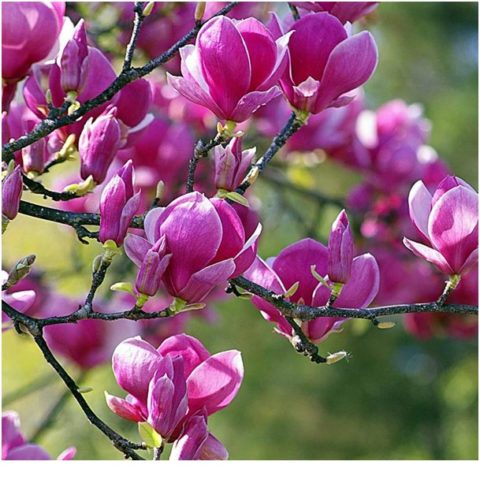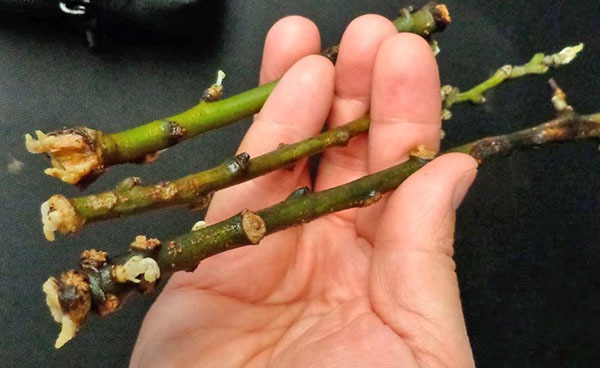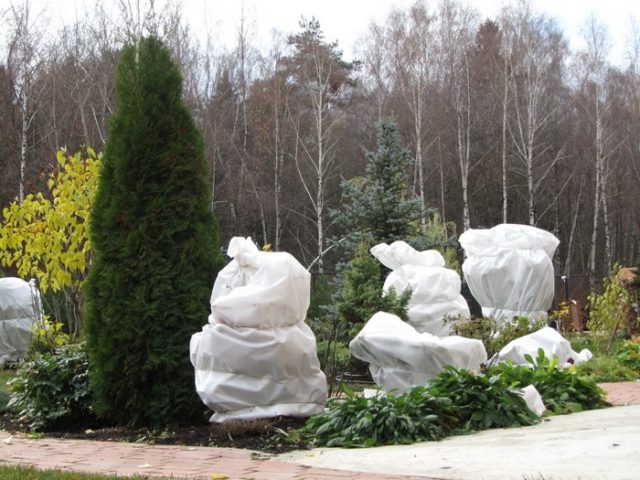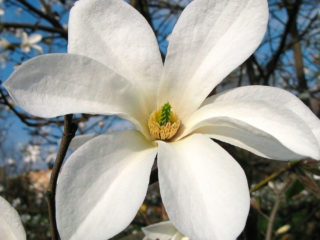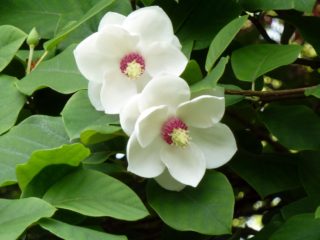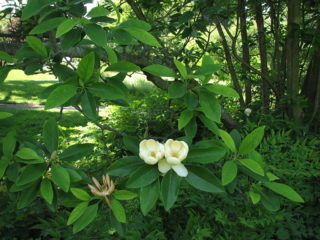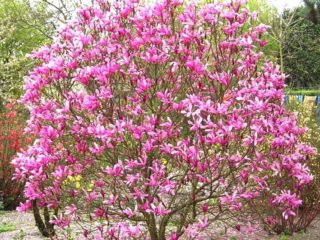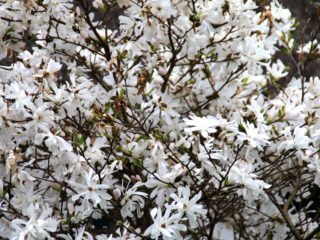Content
Magnolia Black Tulip is an amazingly beautiful variety of crop obtained by New Zealand breeders as a result of crossing the varieties Iolanta and Vulcan. Magnolia Black Tulip is not very well known among Russian gardeners, as evidenced by the almost complete lack of reviews about it.
Description of magnolia Black Tulip
This is an ornamental deciduous tree or shrub up to 5–6 m high with medium-sized green oval-shaped leaves. The pyramidal crown becomes more spreading and wide with age, reaching a diameter of 3 m. The root system is superficial.
The variety is characterized by good frost resistance and is practically not susceptible to diseases.
How Black Tulip magnolia blooms
Magnolia Black Tulip blooms profusely at the very beginning of spring, even before the leaves appear, with large single flowers up to 18 cm in diameter. The goblet-shaped corolla formed by velvety petals gives the flower a resemblance to a tulip.One of the distinctive features of Black Tulip magnolia flowers is their unusual dark purple hue, which is considered one of the darkest among the red-flowered magnolia varieties.
In humid and not very hot summers, the Black Tulip variety can bloom again in mid-June.
Reproduction methods
Magnolia propagates very well vegetatively, that is, by cuttings and layering. Propagation by seeds is extremely rare.
To obtain a daughter plant from layering, in the spring the lower shoot of the mother plant is bent, secured to the soil and covered with earth. After 1–2 years, the branch takes root, it is separated and replanted.
You can start propagating Black Tulip magnolia from cuttings in mid-summer. To do this, young branches of the plant are cut, placed in a sand-based substrate and provided with a constantly moist, warm environment. Rooting takes from 2 to 4 months, and after a year the young shoots can be planted in open ground.
Another common way to grow magnolia is by grafting. A cutting of the Black Tulip variety with vegetative buds is grafted onto the trunk of another crop or a more hardy and frost-resistant variety of magnolia. Most often, this method is used by professional gardeners, since propagation by grafting requires certain skills and adherence to technology.
To grow Black Tulip magnolia from seeds collected in the fall, they are planted in boxes with universal soil and put in a cool place until spring. Before planting young plants in open ground, the seedlings are carefully looked after.
Planting and care
It is best to purchase a Black Tulip magnolia seedling from a nursery or specialized garden center.You should choose planting material with a closed root system, since such plants take root better.
Recommended timing
Despite the fact that magnolia agricultural technology involves both spring and autumn planting, most experienced gardeners recommend planting this plant in open ground in mid-October, after the end of the growing season. An argument against spring planting is the risk of return April frosts, from which magnolia can suffer greatly. Magnolia in a container can be planted throughout the summer.
Site selection and soil preparation
When choosing a place to plant magnolia of this variety, you should avoid open, windy areas. Despite its frost resistance, the plant can be damaged by cold winter winds. It prefers well-lit areas, but direct sunlight has a negative effect on the pigmentation of the leaves - they fade and acquire a light yellow tint. Direct midday sun is especially harmful to young seedlings. Magnolia does well in diffused light and partial shade.
Magnolia Black Tulip is not too demanding on the soil: it will grow best in soils with a neutral or acidic reaction; in substrates with a high content of lime and salts, its growth noticeably worsens. The soil should be fertile, loose, moist, but without stagnant water. Sandy, loamy and clayey soils are well suited.
Preparing a site for planting magnolia involves, first of all, draining the soil, since the plant needs a lot of water, and it does not tolerate stagnant moisture. If the soil is limed, it is acidified with peat.
How to plant correctly
To plant magnolia you need:
- dig a planting hole with a diameter of 100 cm and a depth of 60 cm;
- prepare a nutritious soil mixture of turf soil, peat, sand and rotted compost;
- pour a layer of prepared soil mixture 20–30 cm thick onto the bottom;
- place the seedling in the hole and cover with the remaining soil. The soil should not be compacted so as not to impede air access to the roots;
- water the plant;
- mulch the tree trunk with pine bark, sand or peat.
When planting several trees, the size of adult specimens is taken into account. As a rule, a distance of 4–5 m is maintained between them.
Growing rules
To provide Black Tulip magnolia with comfortable conditions in the gardens of the middle zone, you need to take into account that its homeland is in areas with a warm, humid climate, so regular watering plays a paramount role. Fertilizing and pruning are also necessary to grow a healthy, flowering tree. The achievements of modern selection have made it possible to achieve high frost resistance of this variety, however, proper preparation for winter is an important part of caring for the Black Tulip variety.
Watering
During dry summers, magnolia variety Black Tulip is watered 2-3 times a week with soft water. It is good to use rainwater, settled water, or water acidified with a small amount of peat. Usually about 2 buckets of water are spent on 1 plant.
Young seedlings need more moisture; they are watered once every 7 days at the rate of 30 liters of water per plant.
Mulching will help retain moisture, get rid of weeds and improve the chemical composition of the soil.
Top dressing
For the first 2 years after planting, Black Tulip magnolia does not need feeding.Subsequently, the plantings are fertilized with ready-made mineral complexes or a nutrient solution for watering is prepared independently. Dissolve 1 tbsp in 10 liters of water. l. urea and ammonium nitrate and add 1 kg of cow dung.
Magnolia is fed from the beginning of March until the end of summer. Fertilization with nitrogen complexes is stopped in mid-summer so as not to disrupt the natural preparation of the plant for winter.
Trimming
Black Tulip magnolia is pruned in order to improve decorativeness and general health. There is no need for formative pruning. Immediately after flowering, it is enough to trim off the inflorescences and dried branches, and after winter, cut off the frozen shoots. Branches growing inward should also be removed.
Preparing for winter
One of the mandatory steps in preparing Black Tulip magnolia for winter is mulching the circles around the trunk. It is produced after the first frost. Spruce branches, conifer bark, peat or leaves are used as mulch.
In the middle zone, only young plants (up to 5 years) are covered for the winter. The trunk is securely wrapped in two layers of burlap. Other insulating material will also work. This will protect the plant not only from frost, but also from rodents. If the area with magnolia is blown by winds, it makes sense to cover the tree crown with the same material.
Mature trees can withstand frosts down to -32 ° C, but if a harsh winter is expected, it is advisable to cover them.
The greatest danger for magnolia is posed by return frosts, since when the temperature rises, vegetative processes begin and flower buds are formed that are not able to withstand even a short-term drop in temperature to negative values.
Pests and diseases
Magnolia Black Tulip rarely gets sick; pests pose a great danger to it, primarily rodents that attack the roots and trunk. Special repellers will help you deal with them.
Spider mites greatly harm the plant. Settling on the underside of leaves and multiplying quickly, it can lead to the death of leaves. You can get rid of it by spraying the tree with insecticides or folk remedies, for example, infusion of onion or garlic peels, tobacco dust, mustard powder. It is also useful to carry out preventive spraying of plantings, especially if the weather is hot, dry, since it is in such conditions that insect pests are especially active.
When growing magnolia in soils with a high content of lime and a lack of iron, it can develop chlorosis, in which the leaves turn yellow and fall off for no apparent reason. Acidifying the soil and enriching it with iron chelate will help correct the situation.
Conclusion
Magnolia Black Tulip is a young variety that is gaining an increasing number of fans among gardeners. A flowering tree can become a real pearl of the garden - the incredible beauty of the flowers of this variety invariably attracts the eye. At the same time, agricultural technology is not very difficult - the plant does not have any special care requirements and feels comfortable in the middle zone with minimal care.
